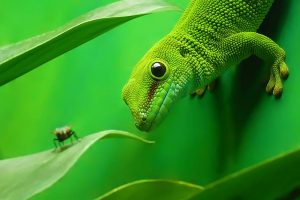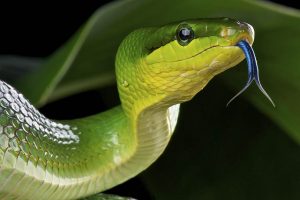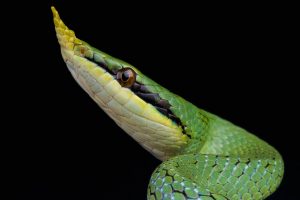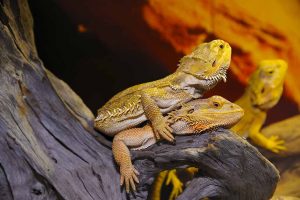
is faced with the very difficult task of imitating a species-appropriate habitat in its terrarium. This is only possible if all the essential elements of the natural habitat are present. Here you will find all important information. The terrarium of the zoo merchant can by no means serve as an example, because it is designed according to commercial considerations and is not intended for permanent accommodation. It is generally too small, over-occupied and equipped with the absolute minimum in terms of equipment and technology. Here are the most important tips for the design of your terrarium. Expertise First of all you should inform yourself about the needs of the species. For detailed information, please refer to the recommendation. Warmth By far the most important point in reptile conservation is temperature management. You should give this aspect top priority.
The heat source must be powerful enough to heat the animals to “operating temperature”. Only when the appropriate heat source has been found is it decided which other lamps can be combined with the heat source for the supply of light and UV. In order to reach this “operating temperature”, sunbathing reptiles need a sun spot with relatively high point temperatures from above. HQI, HQI UV and halogen emitters are suitable for this, depending on the species. Non-sunbathing, dawning and nocturnal reptiles cover their heat demand mainly from air or? With the aid of heating mats, heating coils or heating stones. In order to reach the “operating temperature”, they need a rather mild and homogeneous heat supply.

For the basic lighting, HQI spotlights are most suitable and Lighting tubes. Depending on the type of animal kept, one or the other type of lamp will be considered for youMany turtles and lizards require UV radiation. HQI UV emitters have proven themselves for a more selective irradiation and fluorescent tubes for a two-dimensional irradiation. In this case, care must be taken to ensure a proper UVB contentNo matter how small a terrarium is, there should always be more or less pronounced climatic events. It is divided into two areas: a warm, dry, bright area and a cooler, moister, darker area. In the warm area., UV, heat radiators and other heating elements mounted. The cool area remains darker, is held more humid and, depending on the species, weaker or not heated. In order to provide maximum climatic conditions, heat sources, light and UV lamps are not mounted centrally but as far as possible at the edge. For climbing reptiles, both horizontal and vertical climatic conditions can be created by clever positioning. By this simple measure you have not only created a heat gradient, but at the same time a UV light and humidity gradient.
In subtropical and temperate zones, the temperatures drop significantly at night and thus also metabolism and activity. To avoid metabolic disturbances, you should display all the heat sources of the terrarium at night, preferably by means of a timer. The annual cycles should also be considered. Animals from temperate zones require a several months’ rest with complete food dependency, animals from subtropical zones, at least a week’s rest with reduced heat and food Overwhelming different species.

During summer months, there is a considerable increase in temperature in living rooms. In the terrarium, life-threatening temperatures can be reached quickly. Regular temperature measurements during summer months help, possible situations in time to recognize. Better ventilation, shading or the inactivation of heating systems should be countered in good time. Direct sunlight can heat glass containers so strongly that a life-threatening. threatens! Appropriate temperatures can be maintained much better if the terrarium is in a sun-sheltered place. Terrarium and furnishings Avoid one-sidedness, because one-sidedness generally causes illness! For example, A dry desertarium does not have a damp area. If, on the other hand, no dry spots are present in the moist rainforestarium, diseases such as carapace or skin mycosis are threatened.
Try to create a wide range of different possibilities and conditions in the terrarium, so that your animals are able to regulate their respective needs independently for a good air circulation, the terrarium requires sufficiently large and properly positioned ventilation grids. These should not be provided by furnishings. In the case of poor aeration, stagnation occurs which favors the formation of molds and rotting bacteria. If necessary, small fans (e.g., computer ventilations) can provide relief. The soil substrate? Should largely correspond to the species held. Residents of deserts and high mountains generally prefer water-permeable substrates, e.g. Stony or sandy soils. Reptiles from tropical rainforests require water-storing substrates such as peat, coconut fiber or Xaxim. For other regions, e.g. Mixtures of sand and earth”? the terrarium is decisively influenced by the substrate used, since water-storing materials give much more moisture to the environment than non-water storage. In order to avoid damaging stunts, the substrate is enriched with pebbles or stones until adequate water permeability is ensured.
A good structuring by plants, roots, stones, branches etc. is important for several reasons. It creates microclimazones, hiding places, optical barriers and offers the animals motor incentives. In the natural habitat each animal needs a safe haven. For stress relief and regeneration a safe hiding place is therefore indispensable also in the terrarium. It must not be visible from any point in order to ensure the possibility of a complete withdrawal. You should consider the hiding place basically as tabuzone and where possible neither reconstruction nor visual inspection. Reduce possible sources of danger: stabilize heavy equipment, attach climbing frames, do not use pointed, sharp or rough stone surfaces, minimize impact. combustion should be avoided, heat generating radiators should only be operated with protective grids and heat mats or heating snakes should be installed outside the terrarium. Water vessels shall be designed in such a way that there is no risk of drowning.

Most reptiles are by nature loners and therefore feel in. Some species can be considered as a group, but only with due regard for the group composition. Depending on the type, an appropriate gender relationship should be ensured. As a rule, a clear overhang of females makes sense. In particular the socialization of several males is often problematic. This leads to constant wrangling, harassment of the females and the suppression of weaker members of the family. Territorial species should only be kept in sufficiently large enclosures and with close attention to the group constellation. The ranking of the animals must be carefully observed. For oppressed animals Urgently.
What should be observed when keeping several animals? The larger an enclosure, the lower the stress load. You should avoid an overstuff with animals. Very important is a good structuring with roots, plants, stones, etc. It prevents the animals in constant eye contact with each other, gives orientation in the district boundary and creates micro-rvvv. This leads to significant stress relief, especially for low-blooded animals. It should be noted that the used. They should also stay connected for a long time so that even low-blooded animals have enough time to warm up. Each animal should have a blind spot and a place that is not endangered by competitors to warm up or sunbathe.
www.reptiliendoktor.com
Translation Heike Krüger, edit www.terraristik.cz